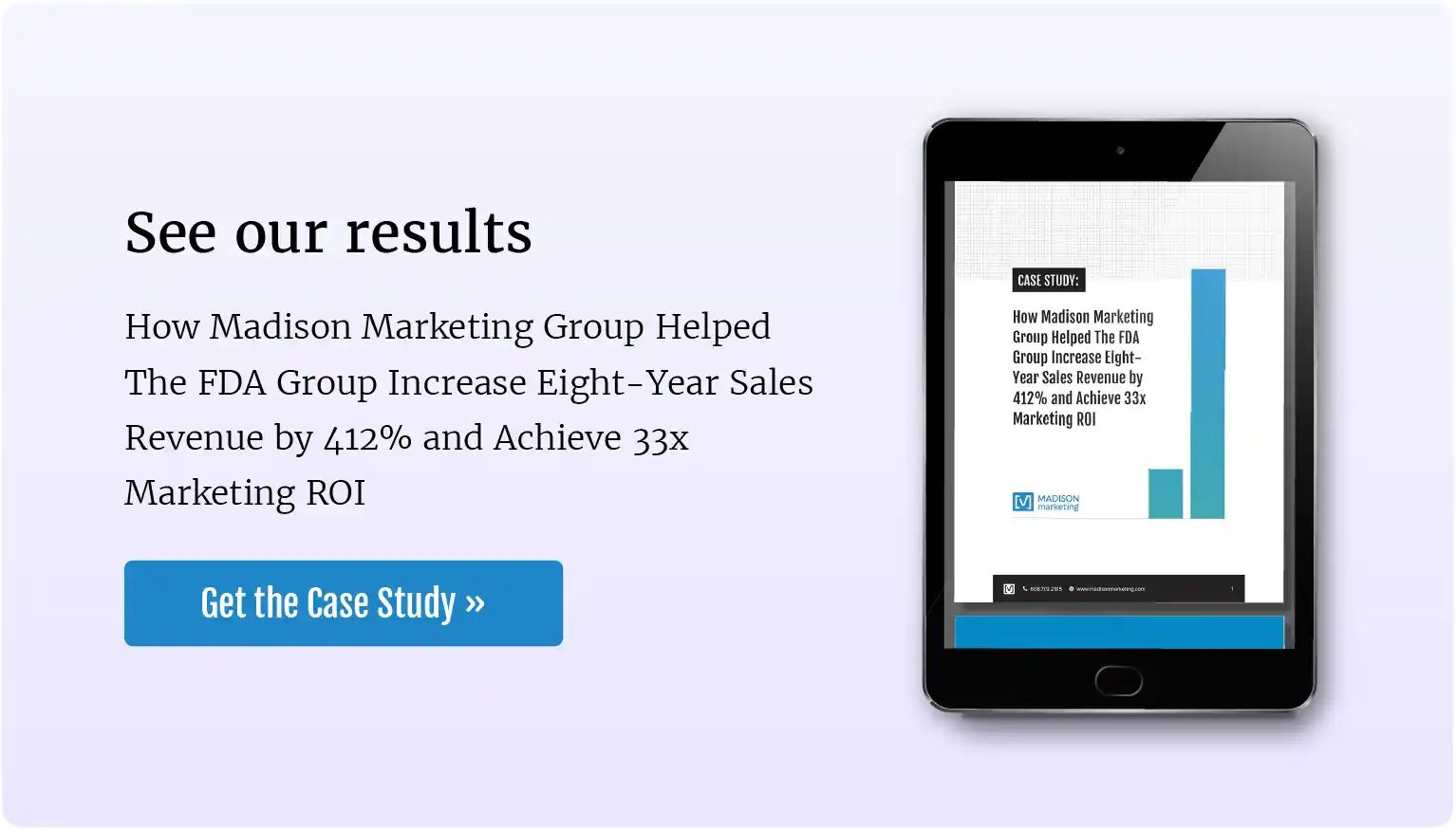If you’re building a new, modern website for your manufacturing company or refreshing an existing one, you have a golden opportunity to capitalize on the benefits of Search Engine Optimization (SEO). SEO involves a broad set of strategies used to make websites more visible in search engine results pages.
But for many manufacturers, the main value of well-executed SEO is that an improved website can be used to better generate leads. From there, if you want to try other digital marketing tactics, like pay-per-click search ads (PPC) or content creation, you will have a steady foundation to build upon. Read on to learn more about:
- What SEO is
- Whether it’s worth the investment
- What to expect from SEO services
- What you can do now to improve your website without hiring help
- Going beyond the basics when you’re ready to level up your lead generation efforts
What is SEO?
Search engine optimization (SEO) is a broad set of strategies businesses use to help their web pages rank higher in organic (unpaid) search engine results.
It requires many skills, such as web development, graphic and web design, copywriting, and analytics reporting. SEO is carried out on your website and sometimes on other websites where your business information is present, like Google Business Profile.
How SEO works, in a nutshell:
SEO is all about getting your pages to rank in search results. How do you do that?
In my opinion, it’s hard to go wrong if you follow these two broad principles:
- Give searchers what they want.
- Provide a great experience for searchers that land on your website.
This is because Google Search (the most popular search engine, which we will focus on in this post) is designed to provide high-quality results that provide what a searcher is looking for.
“After identifying relevant content, our systems aim to prioritize those that seem most helpful. To do this, they identify signals that can help determine which content demonstrates expertise, authoritativeness, and trustworthiness” (Google).
When you search for something, it’s probably safe to say you want to visit sites that are safe, authoritative, easy to use, and relevant to your search, right?
That’s exactly what Google will try to give you. It favors displaying websites at the top of search results that are most likely to give you what you’re looking for, aren’t dangerous to use, have a good reputation, and load quickly (among many other factors).
Based on what Google and its users seem to want, search engine optimizers have come up with techniques like the following:
- Including relevant search terms on pages — When someone types a query into the search engine, they want a relevant answer.
Google uses a number of factors to gauge whether a page is relevant to a given search. One specific factor is whether the page contains the same terms “steel i beams” the visitor used to find the page.
Many companies identify terms like these that relate to specific products, services, and more to ensure a given page sends positive signals to Google. For example, if your bread and butter is steel I-beams, you might want to create a dedicated product page titled “Steel I-beams” that thoroughly covers your offerings in this area. - Securing your website — Google has been encouraging the use of https for some time. Websites that start with “https” use encryption to protect users’ data. When a site is not secure, browsers like Chrome and Firefox notify visitors with a startling security warning, which can scare them away from a site.
- Lightening up your page so it loads faster — We’ve all abandoned a site that wouldn’t load. Speeding up your site provides a better user experience and encourages people to stay longer (signaling engagement).“Our systems would look at page experience aspects, such as if content is mobile-friendly, so that those on mobile devices can easily view it. Similarly, they look to see if content loads quickly, also important to mobile users” (Google).
Many businesses arm themselves with information about how search works to create websites that are easy to find and use, making visitors feel comfortable enough to stick around and check out what the business has to offer.
Here’s an example of what these three techniques could do for a hypothetical manufacturer:
- A potential client of this manufacturer, a builder, needs a new vendor to manufacture building materials for an upcoming construction project.
- He searches for “steel I-beam manufacturer WI.”
- He sees the I-beam product page from earlier on the first page of results. It contains a lot of keywords and text relating to I-beams that are sending Google relevancy signals, which helped it earn this first-page position (among other factors).
- The builder clicks on this result. Because the manufacturer’s site is secure, no startling warning message pops up on Chrome to scare him away.
- The product page loads in less than three seconds because the manufacturer has optimized for page speed. This avoids frustrating the builder with a slow loading page.
From there, modern design, great copywriting, and other marketing practices baked into the site have the chance to convince the builder to become a lead if he’s a good fit.
Is SEO worth the cost?
SEO can be expensive. Naturally, you want to make sure it’s worth the money and hassle.
Bottom line: whether SEO will be a solid strategy for your manufacturing company depends on factors like your clients, the business goals you want to achieve, your budget, and the ability of the vendor you choose to help you.
Here are some examples of situations where SEO can be worth the money.
Goal: lead generation
Many businesses use SEO to generate leads, as we mentioned earlier. If many of your clients use search engines to understand their problems, research solutions and actively seek out new vendors, for example, there’s a good chance that properly executed SEO could yield a good ROI for your manufacturing company.
Well-executed SEO can be very effective at generating leads. For example, One of our B2B clients generated 195% more leads per quarter in 2016 after we put a new digital marketing strategy in place.
This included website improvements and quality content intended to rank well in search results for queries relevant to our clients’ business. By 2020, they had generated 3,226% more leads per quarter.
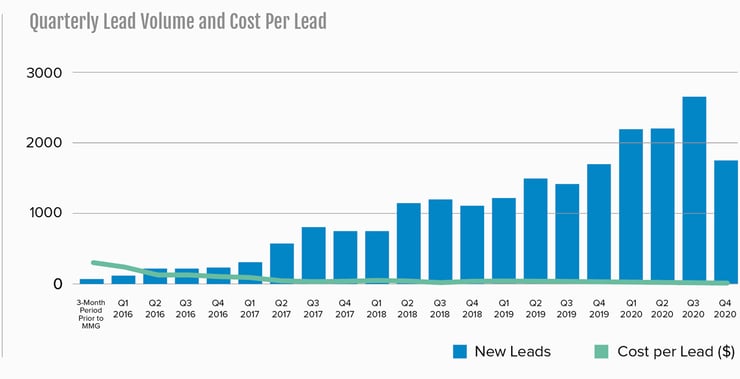
If you own a smaller machine shop, on the other hand, and already get enough sales leads through word-of-mouth or other marketing channels, SEO-powered lead generation might not make sense for you.
Goal: improve your website
Then again, even if you don’t want to invest heavily in SEO as a lead generation tactic, many of its best practices are common sense and result in a website that looks professional and up-to-date, and functions at the level visitors expect.
For example, it’s an SEO best practice to get an SSL certificate and secure your website to protect your visitors’ information from hackers, like personal details or credit card numbers. This also ensures that visitors using certain browsers won’t get scared away by startling warning messages triggered by an insecure website.
The SEO service landscape
While basic SEO best practices are common knowledge—like many other professional services—pricing, quality, and individual service offerings vary widely.
Common service offerings
While you will encounter all kinds of SEO services, here are a few examples:
- Keyword research: finding words and phrases potential customers might use to find businesses like yours.
- Content creation: writing content that is likely to rank in search results and attract visitors.
- On-page optimization: fixing issues to make your website perform better, often as a result of an audit.
- Running SEO audits: diagnosing issues on your website that could prevent you from ranking well in search.
- Local SEO: improving a local business’ search presence in one or more local markets by optimizing on- and off-site for search engine ranking factors unique to local businesses, like Google Business Profile optimization, citation building, and review generation.
Learn more about SEO services.
SEO service pricing
You can pay by retainer, by the hour, or by the project for SEO services. Here are a few price points to chew on.
Expect to pay:
- Mid-size Business Retainer:
$2,501–$5,000 per month is the “most popular pricing tier” in the US, according to Ahrefs, an SEO software company. - Hourly:
$100–$150 per hour is the “most popular pricing tier,” according to the same Ahrefs international survey, rarely exceeding $150 per hour. Although, in our experience, some midsize to large agencies may charge up to $500 per hour. - By the Project:
$501–$1,000 per project is the most common range for project-based SEO, according to Ahrefs. However, for larger manufacturers serving a national or international market, this would generally not be enough to complete a substantial project.
The number of people working on your project (e.g. an agency vs. a single freelancer), specialty skills (such as coding skills), vendor track record, and services offered can affect pricing.
What you need to know about SEO services
SEO service providers can be frustratingly vague about setting expectations, leaving clients wondering what they’re paying for, or why they aren’t seeing immediate results.
Let’s clear up some common points of confusion.
SEO is a long-term strategy. It takes time to see substantial results.
In our experience, clients begin to see more substantial results after six months or so into our ongoing retainers, but it varies.
This long wait is due to a number of factors, including:
- The age of your domain (web address): Pages on new domains often take longer to rank than more established older ones.
- Whether the domain has used unscrupulous SEO tactics in the past
- The level of competition in search results for your industry
- The effectiveness of your SEO strategy
No agency can 100% guarantee that you’ll show up for the precise keyword you want to appear for or get the precise rank you want.
Your ability to rank #1 is affected by at least two parties beyond your control:
- The search engines. They make the rules (and change them regularly, and leave some of them unknown). At the end of the day, it’s the Google algorithm’s call whether you’re #1 or #100.
- Competitors. They may have advantages over you for certain searches, such as more time and money to spend on marketing. They may also be paying to show up for certain keywords using paid search ads, which often appear above unpaid, link-and-text results.
Search engine optimization is just that—improving the odds that your pages will get seen by the right people.
A good agency should be able to help you use SEO to help achieve business goals. Competent optimizers keep track of changes in industry best practices and trends to ensure the techniques they are using are data-driven, up-to-date, and honest to maximize results.
- Competent optimizers make sure their clients create content that effectively addresses topics their target audience searches for when seeking to understand the problems they face and identifying solutions to those problems.
- Competent optimizers are able to determine which keywords are most likely to be used by the clients’ target audience (more likely to result in qualified leads), are relevant to their business goals, and will be reasonably easy to rank for.
- Competent optimizers know how to analyze competitors’ content to uncover potential keywords they’re targeting, what they’re doing well or poorly, and opportunities they’ve missed. They may even be able to guess which strategies they’re using that could also work for the client.
And this brings us to the types of SEO providers to watch out for.
Sketchy SEO
You can certainly get cheap SEO services, but this can be a false economy. Sometimes services are inexpensive or get (temporarily) fast results because they’re inexperienced or using dishonest “black hat SEO” practices. The latter can hurt your search visibility.
A Backlinko survey of 1,200 business owners found that “business owners that spent less than $500/month were 75% more likely to be dissatisfied than those that invested at least $500/month on SEO.”
Steer clear of these things and the people who offer them:
- Link farms and paid links: Never buy backlinks. Getting caught will likely result in Google burying your site.
- Trading guest posts for links: Don’t respond to guest bloggers that trade links for low-quality articles. Google may penalize you. Here's Google, on link schemes.
- Keyword-stuffing: Don’t repeat the exact same keywords on a page over and over again to try to rank. For example, “Our plastic honey bear lids are the best quality plastic commercial honey bear lids for your plastic honey bears.”
- Cloaking or invisible text: Hiding the real destination of a link (cloaking) and showing different versions of a page to crawlers is a very bad practice. You should only keep one version of a page for both search engine crawlers and users and ensure that users can tell the difference between website content and ads.
Check out Google’s rulebook (webmaster guidelines).
Of course, this doesn’t mean that a more expensive SEO service provider is going to be the right fit either. Be sure to vet them thoroughly before signing on any dotted lines.
Learn more about the cost of SEO and how to vet an agency.
Quick tips for improving your manufacturing company’s SEO now
Make your site effortless to use.
Ensure that text is easy to read.
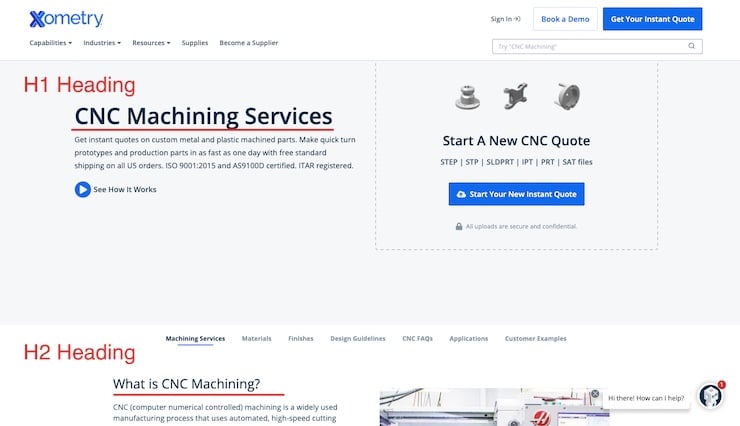
Source: Xometry
Readers online love to skim. One of the easiest ways to improve your visitors’ experience is to make text easier to read. You can do this by:
- Using headings of different sizes to efficiently tell visitors (and search engines) what each section is about.
- Using lists
- Writing shorter sentences
- Limiting paragraph length to five lines
- Using a contrasting text color so it doesn’t blend into the background
- Ensuring text is at least 16px large so it looks good on any device
Use images on your site, but make sure they aren’t too big.
Images are a great way to improve the user experience of your site, but images that are too large can slow your page load speed and hurt user experience. Image optimization is one of the easiest ways to help speed up a slow-loading page.
Resize your website images to fit the width of the text or heading on the page where they appear.
- On the largest-screened device you have, visit a page with images you may want to resize using the Chrome browser.
- Right click and select “inspect.”
- In the window that pops up, click the box icon in the upper left corner.
- Then, hover over the image. The selected area will get highlighted in blue, and a box will appear with information, including the display size of the image. In this case, the computer is displaying the image as 940 x 626.98 pixels wide.
- Right click on the image and select “view image in new tab” to see the actual dimensions of the image.
- Right click on the image and select “download image.”
- Resize the image.
- Make sure to save resized photos as JPGs.
- Replace the photos on your site with these lighter versions.
Link to relevant pages.
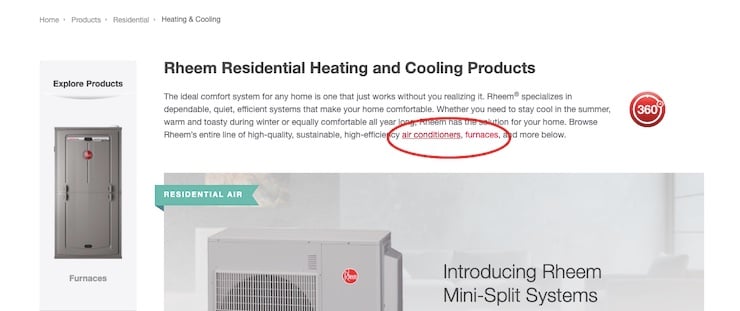
Source: Rheem
If you reference a topic that is covered on another page of your site, link to it. Linking to relevant pages on your own site is helpful to readers and search engines alike.
If you use someone else’s page as a source of information, link back to it. Avoid putting yourself in a position where you have to link to your competitors, as this can help boost their search visibility.
Check for broken links.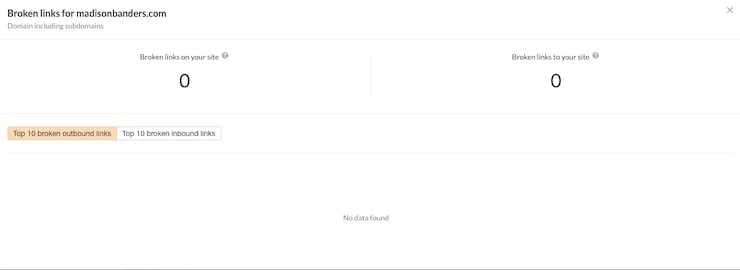
Source: Ahrefs
Clicking on a link only to be told it no longer exists is annoying for users. To prevent this from happening on your company’s site, use a link checking tool to find these problems and redirect visitors to the updated version or back to your home page.

Source: Midland Plastics
Getting an SSL certificate makes your site safer to use. To see if your site is secure, visit it and click in your browsers’ address bar. If your site’s address starts with “https,” you’re already good to go. If not, learn more about fixing this issue.
Attract visitors and provide what they want.
Write and implement keyword-laden title tags and meta descriptions (“metadata”) on each page.

How this data looks in search results. Note: sometimes Google doesn’t use all the text you supply; source: Google
Most modern content management systems (Wordpress, HubSpot, etc.) allow site editors to easily set title tags and meta descriptions (often referred to collectively as “metadata”) on a page by page basis.
Consider metadata to be a preview of what your page’s search result will display. They act as an elevator pitch for your page, telling searchers: 1) what your page is, 2) what it contains, and 3) why they should click on it. Learn how to write great search result titles and descriptions.
Write thoroughly.
Source: Superior 1 Solutions
Take a look at each of your pages, especially important ones like your service pages. Have you left out any useful information that potential clients might want to know before deciding whether to do business with you?Consider how deep you need to go to fully answer a question or address a topic.
While you should never pad a page with fluff, it’s usually better for SEO if you provide as much relevant detail on a page as you think a customer would find useful.
Backlinko did a study that found that “content that covers an entire topic on a single page may have a direct or indirect relationship with rankings.”
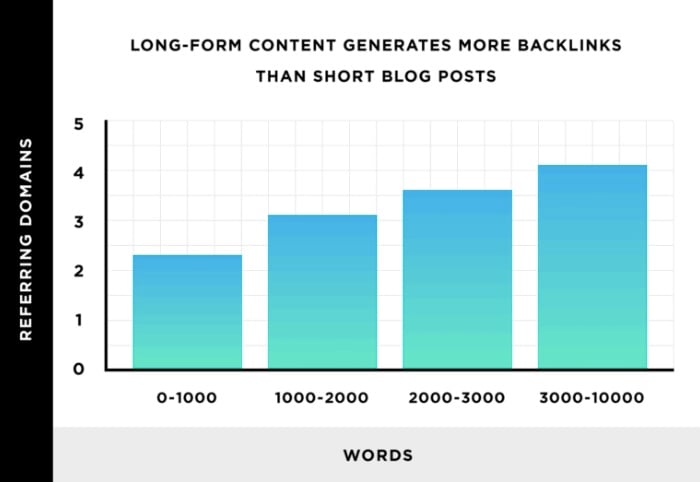
Source: Backlinko
Another one of their studies found that longer content tended to get linked to from other websites more often, which is significant, since these external links are one of the major factors Google looks at when ranking pages.
Read our free guide to SEO for more beginner best practices.
Beyond the basics: leveling up your SEO
If you’re considering investing in SEO for the future, here are some important improvements that should be on your radar if you hope to make site improvements and/or generate leads from search engines. These tend to be heftier, more technical projects that will most likely require an expert’s help.
Optimize your site for mobile devices.
Does your site look good on any device?

Old vs. new mobile designs; Example: Columbia Vehicle Group
Not only does a mobile-friendly site improve mobile visitors’ experiences, but if your site is new, Google judges the quality of your site from the mobile version, first and foremost.
This means not having a complete or pleasant mobile site could hold you back from ranking higher in search results.
To see how your site measures up, try this free Google test.
Target keywords with new content.
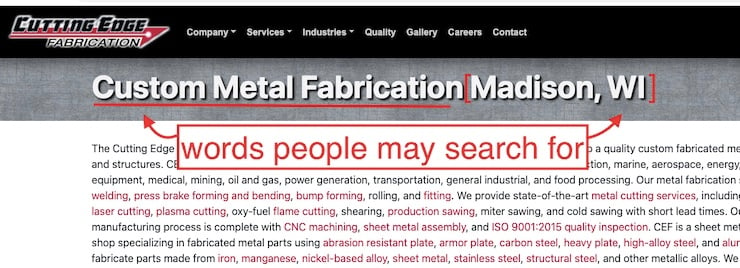
Source: Cutting Edge Fabrication
Identifying which words potential customers use to search for businesses and services like yours (keywords), tactfully including these terms on relevant pages of your site (or better yet, creating new pages completely devoted to each of them), and ensuring you thoroughly cover the keyword’s topic and subtopics in as much detail as your audience seems to want can help attract potential customers to your site.
Audit your site for technical SEO issues.
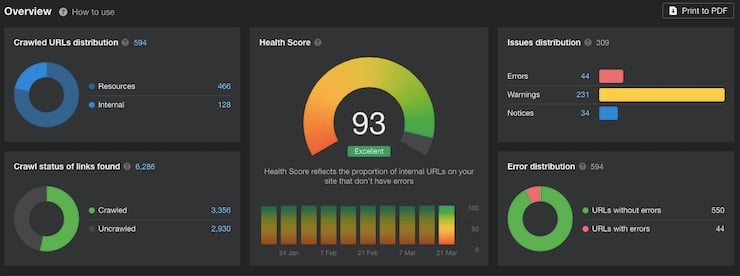
Source: Ahrefs
Identify technical problems with your site that create a poor experience for visitors or make it hard for search engines to assess your site.
For example, broken links causing visitors to land on 404 pages and robots.txt files blocking parts of your website from search engines trying to scan your site can both contribute to serious SEO problems. Free site tools like Website Grader or Ahref’s site audit might be a good place to start.
Establish an appropriate internal linking structure.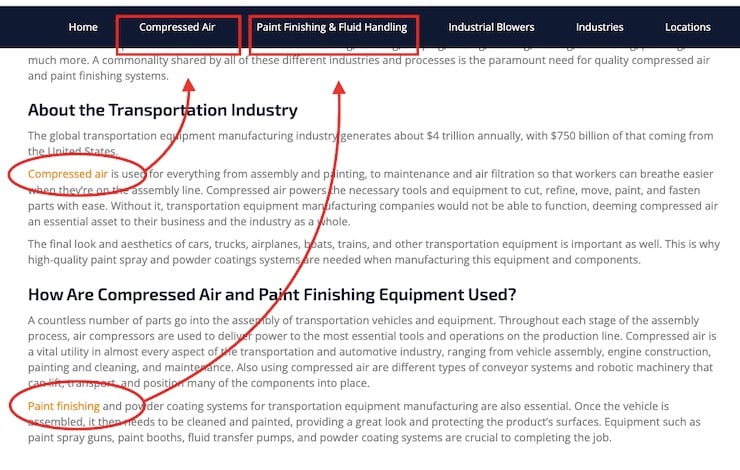
Smart internal linking from an industry page to a service page; source: C. H. Reed
If you followed the tips from the previous section, you’re already linking from one relevant page of your site to another, and to external sources. However, it’s often smart to strategically link from a particular page on your site to another for SEO reasons.
For example, if one of your pages (such as your homepage) is getting a lot of traffic, you can sometimes boost the traffic potential of other pages on your site by linking from this popular page to ones that get less traffic.
Learn more about internal linking best practices.
Take a second look at how your site is organized.
Rethinking how you organize your site can improve its internal linking structure and make your site almost effortless for visitors to find all the important pages.
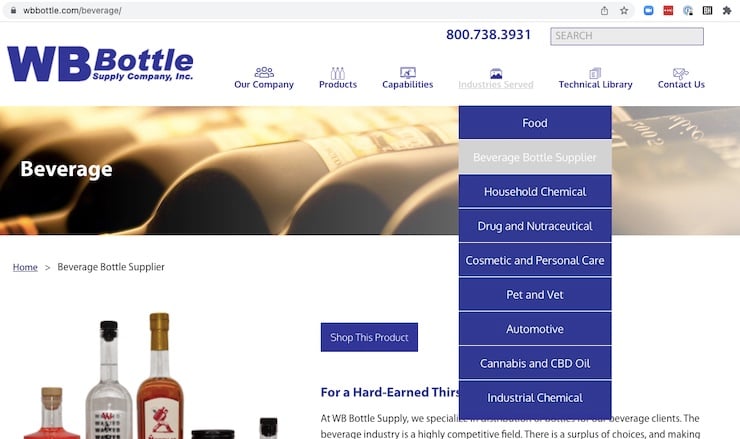
Simple design, logical organization, and clear labels makes this bottle manufacturer’s website easy to navigate; Source: WB Bottle
Pay special attention to a few key navigational site elements. Site navigation are the elements that you use to get around to different pages, such as your site menu:
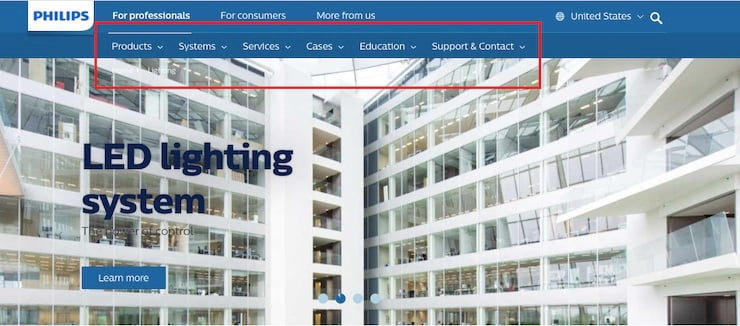
The menu at the bottom of your site (footer navigation);
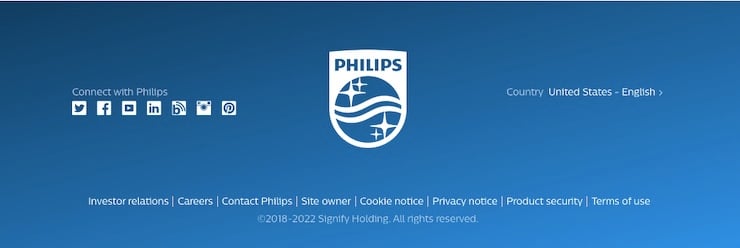
And breadcrumbs (which tell you where you are and how you got there).
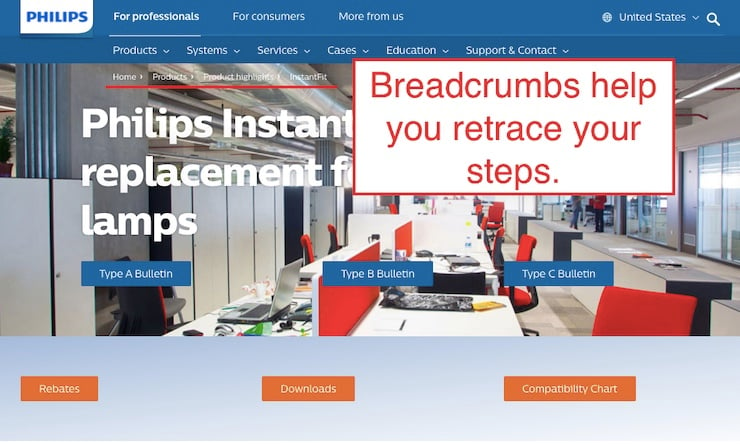 Source: Philips
Source: Philips
Look at your main site menu (top level navigation), and ask yourself:
- Are any important pages only accessible by clicking through several other pages? Maybe they need to be moved where they’re easier to find.
- Do all child pages under a particular parent menu item fit with each other and with the parent? If not, move any misfit child pages to a more logical parent, or leave it out of your main navigation. For example, you could stash it in the menu at the bottom of your site in the footer menu, or just link to it from another page if it’s not that important.
- Does your navigation menu contain seven top-level menu items or fewer? It’s best to keep it simple, and list subpages (such as specific industry or service pages) in drop-down menus below a more generic overview page.
- Do important topics that are part of an existing page deserve their own, new page? In our experience, the more dedicated the page, the better chance it has to rank in search results.
- Should an item in your site menu that is not particularly important be removed and put in the footer menu instead?
- Do all of your site menu item labels describe exactly what people will find in that part of the site (e.g. services, about)?
- Is your homepage button the first item in your menu? Is your contact button the last item in your menu?
Learn more about designing menus effectively.
Conclusion
SEO is a lot of work, but there are actions you can take today to improve your manufacturing company’s search visibility. More advanced techniques require specialized skills to execute well, and search engines are constantly evolving, forcing experts to modify their strategies.
If this sounds like more work than you have time for, partnering with an effective agency can take this off your plate.
To get a better idea of what would be most beneficial for your site, give us a call.
Or, check out one of our free case studies to see how we’ve helped other companies generate leads with SEO content and better websites.
Topics: Search Engine Optimization



